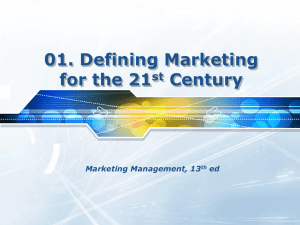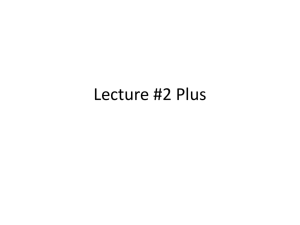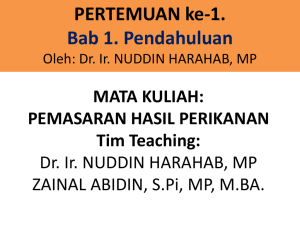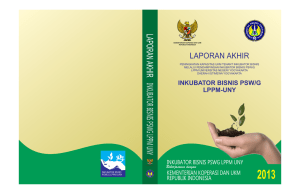Intro to CUSTOMER RELATIONSHIP MANAGEMENT (CRM)
advertisement
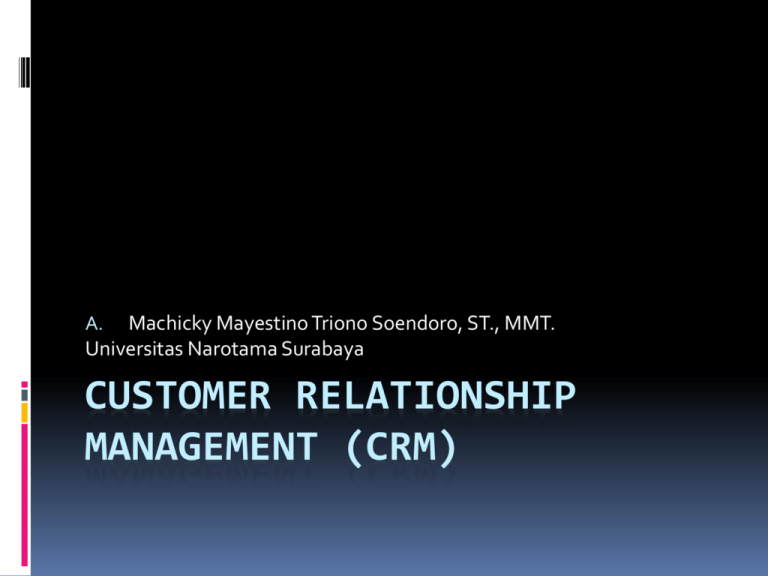
Machicky Mayestino Triono Soendoro, ST., MMT. Universitas Narotama Surabaya A. CUSTOMER RELATIONSHIP MANAGEMENT (CRM) PENDAHULUAN UU Teknologi adalah : cara/metode serta proses /produk dihasilkan dari pemanfaatan berbagai disiplin ilmu pengetahuan menghasilkan nilai bagi pemenuhan kebutuhan, kelangsungan dan peningkatan mutu kehidupan manusia Information Technology From Wikipedia, the free encyclopedia Information technology (IT) is the acquisition, processing, storage and dissemination of vocal, pictorial, textual and numerical information by a microelectronics-based combination of computing and telecommunications.[1] The term in its modern sense first appeared in a 1958 article published in the Harvard Business Review, in which authors Leavitt and Whisler commented that "the new technology does not yet have a single established name. We shall call it information technology."[2] [1] Longley & Shain 1985, p. 164 [2] "information technology (subscription required)", Oxford English Dictionary (2 ed.), Oxford University Press, 1989, http://dictionary.oed.com/, retrieved 20 November 2010 Information and communications technology From Wikipedia, the free encyclopedia Information and communications technology or information and communication technology,[1] usually called ICT, is often used as an extended synonym for information technology (IT) but is usually a more general term that stresses the role of unified communications and the integration of telecommunications (telephone lines and wireless signals), intelligent building management systems and audio-visual systems in modern information technology. ICT consists of all technical means used to handle information and aid communication, including computer and network hardware, communication middleware as well as necessary software. In other words, ICT consists of IT as well as telephony, broadcast media, all types of audio and video processing and transmission and network based control and monitoring functions.[2] The expression was first used in 1997[3] in a report by Dennis Stevenson to the UK government[4] and promoted by the new National Curriculum documents for the UK in 2000. ICT References [1] Sometimes used with technologies in the plural. Originally, only information and communications technology (with communications in the plural) was considered correct since ICT refers to communications (in the sense of a method, technology, or system of sending and receiving information, specifically telephone lines, computers, and networks), not communication (the act of sending or receiving information by speaking, writing, phoning, emailing, etc. or a message containing such information), and the older form (information and communications technology) is still the only one recorded in professionally edited reference works (e.g. Oxford Dictionaries Online, Computer Desktop Encyclopedia, Webopedia, and Encarta® World English Dictionary) and preferred by many style guides (e.g. Editorial Style Guide of the Republic of South Africa. Nevertheless, the form information and communication technology is becoming increasingly common and is now used in about half the books that can be searched using Google Books and is for example also used by the [2] International Telecommunication Union. [3] http://foldoc.org/Information+and+Communication+Technology ^ [4]http://specials.ft.com/lifeonthenet/FT3NXTH03DC.html ^ The Independent ICT in Schools Commission (1997) Information and Communications Technology in UK Schools, an independent inquiry. London, UK. Author: chair Dennis Stevenson Management information system From Wikipedia, the free encyclopedia A management information system (MIS) is a system that provides information needed to manage organizations effectively.[1] Management information systems are regarded to be a subset of the overall internal controls procedures in a business, which cover the application of people, documents, technologies, and procedures used by management accountants to solve business problems such as costing a product, service or a business-wide strategy. Management information systems are distinct from regular information systems in that they are used to analyze other information systems applied in operational activities in the organization.[2] Academically, the term is commonly used to refer to the group of information management methods tied to the automation or support of human decision making, e.g. Decision Support Systems, Expert systems, and Executive information systems.[2] MIS to ERP and beyond The term "MIS" arose to describe these kinds of applications, which were developed to provide managers with information about sales, inventories, and other data that would help in managing the enterprise. Today, the term is used broadly in a number of contexts and includes (but is not limited to): decision support systems, resource and people management applications, Enterprise Resource Planning (ERP), Supply Chain Management (SCM), Customer Relationship Management (CRM), project management and database retrieval applications. MIS References [1] http://www.occ.treas.gov/handbook/mis.pdf ^ [2] O’Brien, J (1999). Management Information Systems – Managing Information Technology in the Internetworked Enterprise. Boston: Irwin McGraw-Hill. ISBN 0071123733. Oleh karenanya adalah sangat penting bagi produsen untuk mengetahui hal-hal kunci tentang: “siapa (who)” “apa (what)” “di mana (where)” “bilamana (when)” ? “bagaimana (how)” ”mengapa (why)”; menyangkut segala sistem yang berhubungan dengan sistemnya sendiri. Penelitian “Sybase Customer Asset Management Solution” oleh www.sybase.com menunjukkan hal-hal yang menarik sebagai berikut: • Memerlukan biaya enam (6) kali lipat untuk menjual sesuatu kepada konsumen baru daripada kepada konsumen lama. • Konsumen tertentu yang tidak puas akan suatu produsen akan menyebarkan berita tentang ketidakpuasannya ini ke sekitar 8-10 orang lain. • Suatu perusahaan dapat meningkatkan keuntungan niaganya sebanyak 85%, dengan biaya 5%, guna pengelolaan hubungan dengan konsumennya untuk mempertahankan kesetiaan konsumen tersebut. • Kemungkinan (probabilitas) penjualan kepada konsumen baru sukses adalah 15%, kemungkinan hal yang sama terhadap konsumen lama adalah 50%. • Sebanyak 70% konsumen yang tidak puas akan bersedia meneruskan hubungan niaga itu dengan membeli produk atau layanan yang sama atau lainnya, bila keluhan itu ditanggapi dengan cepat. • Lebih dari 90% perusahaan di dunia, tidak memiliki sistem penjualan dan pelayanan terpadu yang dapat mendukung E-Commerce (perniagaan yang menggunakan layanan berbagai sistem elektronik) SYSTEM ANALYSIS INPUT Man Machine OUTPUT PROCESS/ PRODUCTION Money Services Material Waste Methodology Etc. (5 M) + Finished Goods BLACK BOX Information Time Etc. Feeding Back System Closed Loop I – P – O System Wayne C Turner – Joe H Mize - Kenneth E Case “Introduction to Industrial and Systems Engineering” Porter’s Five Competitive Forces DEMOGRAFI LINGKUNGAN UMUM SOSIAL BUDAYA PENDATANG BARU (New Entrants) POLITIK HUKUM LINGKUNGAN PASAR BERSAING A PEMASOK (Suppliers) PEMBELI (Buyers) PERSAINGAN (Rivalry)B LINGKUNGAN INDUSTRI MAKRO EKONOMI PRODUK & LAYANAN SUBSTITUSI (Substitutes) TEKNOLOGI LINGKUNGAN PERUSAHAAN Design & Manufacturing Human Resources Purchasing & Outsourcing Distribution Strategies of Competition & Objectives Research & Development Financial Support (Profit, Market Share, Social Services, etc.) Sales Marketing Tarek M Khalill’s Management of Technology, based on Porter’s Five Competitive Forces, 1980 Aktivitas Value Chain Michael Porter Sumber : M.E. Porter, Competitive Advantage, New York, Free Press 1985 Michael Porter’s Generic Strategy Theory Sumber : M.E. Porter, Competitive Advantage, New York, Free Press 1985 General Ledger Account Receivable Cash Flow Forecasting Intercompany Accounting Account Payable Consolidation Bank Management Allocation , Accrual Fixed Asset Billing Receipt CUSTOMER Delivery Sales Payments Purchase Sales Order Pricing Shipping Invoicing Distribution BOM Workcenter Routing MRP MPS Production Execution Purchasing Inventory Invoice Verification Warehouse Mgmnt. Invoice VENDOR Collection EB = EC + BI + CRM + SCM + ERP Komponen rumusan E-Business Strauss-Frost EB = SCM + CRM + SeCM + KT + ERP + EP Komponen rumusan E-Business Kalakota-Robinson EB: E-Business EC: E-Commerce BI: Business Intelligence CRM: Customer Relationship Management SCM: Supply Chain Management SeCM: Selling Chain Management KT: Knowledge Tone ERP: Enterprise Resource Planning EP: E-Procurement ASPEK PASAR DAN PEMASARAN Kondisi Makro Ekonomi • Pertimbangan tingkat pertumbuhan penduduk • Pertimbangan tingkat suku bunga • Pertimbangan nilai tukar mata uang • Pertimbangan pertumbuhan ekonomi • Pertimbangan tingkat pendapatan • Pertimbangan tingkat perkembangan pasar Pasar dan Market Share o Jangan menjual produk yang dapat kamu buat, tetapi buatlah produk yang dapat kamu jual. Ini tentang apa yang dapat kita jual, bukan apa yang dapat kita buat o Pasar, adalah seluruh potensi konsumen yang ada yang dapat menyerap produk yang dijual o Market share, adalah persentase total penjualan pasar suatu perusahaan untuk suatu jenis produk tertentu (pangsa pasar) Penentuan Pelanggan o Perilaku konsumen (consumer behavior), yaitu studi dari proses keputusan mengapa konsumen dapat membeli dan mengkonsumsi produk-produk o Faktor-faktor personal dan kebiasaan perilaku membeli, yaitu faktor psikologis, personal, sosial, dan kultural Segmenting o Segmentasi akan difokuskan atas dasar psikologis konsumen, dengan melibatkan satu atau beberapa variabel perilaku, yang berupa manfaat produk terhadap konsumen o merupakan tindakan mengidentifikasi dan membentuk kelompok pembeli yang terpisahpisah yang mungkin membutuhkan produk dan bauran pemasaran tersendiri o Segmentasi Geografi, Demografi, Psikografi, Perilaku Targeting o Targeting, teori tentang bagaimana menentukan target pasar yang akan dimasuki, dan target seharusnya dimasuki o tindakan memilih salah satu atau lebih segmen pasar untuk dimasuki. o Ukuran dan Pertumbuhan Segmen, Daya Tarik Struktural Segmen, Sasaran dan Sumber Daya Perusahaan (matriks Pasar-Produk) Positioning o Positioning, teori tentang bagaimana posisi produk yang dianalisa relatif terhadap pesaing o Tindakan membangun dan mengkomunikasikan manfaat dan kelebihan produk di dalam pasar o Penentuan posisi menurut atribut, manfaat, pemakai, pesaing, kualitas, produk Kegunaan STP o Ketiga point tersebut sangat berguna dalam menentukan strategi persaingan suatu produk, yaitu mengenai : Segmen mana yang seharusnya dimasuki, dengan melihat peta persepsi konsumen terhadap masingmasing produk. Memilih pesaing Bagaimana memposisikan yang terbaik dalam segmen yang dipilih Penentuan Persaingan o Analisis pesaing, yaitu mengenali tujuan, strategi, kekuatan dan kelemahan, serta reaksi pesaing o Strategi bersaing, yaitu menyeimbangkan orientasi pelanggan dan pesaing Red Ocean Strategy (win-loss, me-too, head to head) Blue Ocean Strategy (win-win, innovation, diferrentiation) Pemasaran o Adalah proses perencanaan dan pelaksanaan konsepsi, penetapan harga, promosi, dan distribusi dari gagasan, barang, dan jasa untuk menciptakan pertukaran yang memuaskan tujuan perseorangan dan organisasi. o Bauran pemasaran, adalah gabungan strategi produk, penetapan harga, promosi, dan distribusi yang digunakan untuk memasarkan produk-produk. Bauran Pemasaran o Bauran Pemasaran (marketing mix, 4 P : Product, Price, Place, Promotion) o Keputusan produk (bauran produk, lini produk, merk) o Keputusan harga (penetapan harga, perubahan harga) o Keputusan lokasi (penentuan jaringan distribusi, tempat usaha) o Keputusan promosi (penentuan strategi promosi, media promosi) Keputusan Pemasaran 1. Berapa pasar potensial yang ada. 2. Berapa pangsa pasar yang akan diraih. 3. Keputusan strategi Pemasaran yang akan diterapkan.
